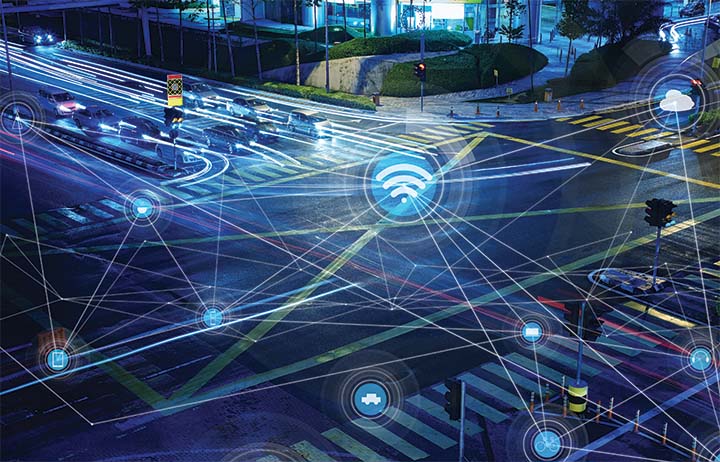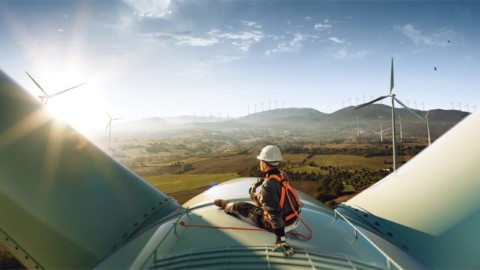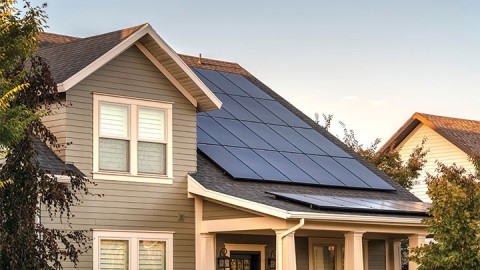by Adam Turner, Contributing Journalist, iMOVE
Treating electric vehicles as ‘batteries on wheels’, an innovative new technology has the potential to play a key role in Australia’s renewable energy and net zero emissions strategies, while letting electric vehicle (EV) owners make the most of their investment.
With Australia leading the world in the number of rooftop solar panels per capita, many households are already evaluating the benefits of an in-home battery for storing excess solar power. As EVs become more common, owners and grid operators will also be able to take full advantage of the battery sitting in the driveway.
Through iMOVE Cooperative Research Centre (iMOVE), The University of Queensland (UQ) has launched an international trial to determine whether the spare battery capacity in EVs could be used to drive the uptake of renewable energy, power homes and support the grid.
The ‘Electric vehicles: Supporting uptake, investigating smart charging’ project focuses on studying how EV owners currently use and charge their vehicles. It aims to understand how EV adoption could be accelerated, by examining consumer willingness to purchase EVs and participate in smart charging programs.
How does it work?
As with in-home batteries, in-vehicle batteries can be bi-directional – used to store excess solar power and then provide it back to the home when needed – known as Vehicle-to-Home (V2H).
Using EV batteries to power homes in the evenings, rather than drawing expensive peak electricity from the grid, allows households to both reduce power bills and the peak load on the energy network.
If required, vehicles can recharge from the grid late at night, when off-peak electricity is cheaper, to ensure they have enough charge for the next day’s driving. Just like in-home batteries, the excess power stored in EVs can also be offered back to the energy provider, a fledgling concept known as Vehicle-to-Grid (V2G).
Treating networks of EVs as virtual power plants adds capacity to the grid, manages EV charging, and allows for better utilisation of distributed energy and assets. This can lower infrastructure costs and better manage peak demand, to help providers bring down energy costs.
EVs can also be utilised to store excess grid power during the day to combat voltage fluctuations and other power quality issues, which can force home solar systems to reduce their output on sunny days when too much energy is being fed back into the grid.
While there is a range of technical and infrastructure challenges to overcome, V2G has the potential to make a significant contribution to Australia’s energy needs. It can also play a key role in assisting the transport sector in reaching net zero carbon emissions by 2050.
Transport and energy sector engagement
One of the key challenges with implementing a national V2G strategy is understanding whether EV owners are ready and willing to surrender control over how and when their vehicle charges. In this project, UQ has partnered with EV analytics platform Teslascope to address these questions.
The study is recruiting Tesla owners internationally to better understand driving and charging behaviour across the globe. iMOVE Managing Director, Ian Christensen, said for electricity to be a good candidate for replacing fossil fuels, there needs to be increasing engagement between the transport and energy sectors.
“iMOVE stands ready to assist industry participants to engage with this question of what technology they are going to utilise in order to become more sustainable into the future,” Mr Christensen said.
“We’re not advocates of any particular solution, except we would observe that the transport sector will need a range of solutions to curb its carbon emissions because there’s no one solution that will satisfy all the transport requirements.”
Enormous power potential
While many new EVs coming to market offer a driving range of more than 400km, most private vehicles are driven less than 50km a day.
E-Mobility Research Fellow at UQ and Head of Policy, Electric Vehicle Council, Dr Jake Whitehead said, in theory, if all of Australia’s 16 million cars were EVs with a modest driving range, they could store enough energy to power the entire country for 24 hours.
“I’m not suggesting the entire country will be solely powered by electric vehicles, but the potential storage capacity offered by an orchestrated V2G program illustrates that it could have an important role to play in soaking up excess renewable energy and providing it back to the grid during peak demand,” Dr Whitehead said.
“The excess energy capacity in EVs presents an incredibly valuable resource, but only if EV owners are willing and able to share it, and are properly compensated for doing so.”
The study offers a unique opportunity to better understand EV driving and charging behaviour in different markets, Dr Whitehead said, as well as the opportunities for EVs to provide energy services and generate extra income for owners. It will initially involve up to 500 Tesla owners, and use Teslascope’s analytics platform to collect vehicle usage data.
In exchange for secure and confidential access to their usage data, participants are provided with a free 12-month premium Teslascope subscription. The study is initially limited to Tesla owners in Australia, North America and Europe.
As more manufacturers open up access to vehicle data, future studies will be able to consider expanding to include other EV brands.
“With the support and trust of users, we will be able to leverage these learnings to influence government policy – including the rollout of public charging infrastructure,” Dr Whitehead said.
“We also aim to use the findings of this research to address some of the common misconceptions around how EV owner use their vehicles and highlight how this technology provides far greater benefits than risks to the energy sector.”
The challenges
UQ PhD student Thara Philip said for initiatives like V2G to succeed, it is important to understand the current behaviour and attitudes of EV owners, to see whether they are well-aligned with the requirements of V2G or present additional barriers.
“Range anxiety” is a recurring theme in Australia’s EV debate, with a concern that vehicles could run out of charge during a long journey.
This can make EV owners apprehensive about participating in V2G networks and handing control of their vehicle’s charging to the grid operator.
“We need to address the question of what’s required to ease range anxiety,” Ms Philip said. “EV owners might be prepared to let their electricity provider choose when to charge and discharge their vehicle, if the owner could be assured that in the morning they’d always have a minimum range of 150km, for example.”
“There is also the potential impact of price signals on consumer behaviour, such as a larger economic return for participating in V2G, or paying a premium for overriding the smart charging controls and choosing to charge your vehicle from the grid during peak time.”
Apart from consumer willingness, a wide range of challenges must be addressed throughout the EV ecosystem before widespread V2G adoption can become a reality. Support for V2G bi-directional charging plugs and standards from EV manufacturers, as well as in-home charging infrastructure, still varies widely.
Grid connection agreements with energy providers also present further challenges. Of the various EV charger plugs across the globe, only Japan’s CHAdeMO standard currently supports V2G.
While V2G support is on the roadmap for some of the other charging standards, Dr Whitehead said it could be five to ten years before it becomes commonplace in EVs, and the functionality will likely come at an additional cost.
A technical concern is the impact of the extra charge cycles on the lifespan of the battery. While smart algorithms can optimise charging to minimise the impact of extra usage, participating in V2G is not covered under current battery warranties from many EV manufacturers, including Tesla.
In theory, V2G should take a toll on battery life compared to an EV which was only used for transport, with perfectly optimised charge cycles, Dr Whitehead said. “Yet, the reality is that most electric vehicles aren’t charged perfectly in an optimised way,” Dr Whitehead said.
“Studies have found that, compared to how the average person is actually charging an electric vehicle right now, participating in V2G and smart charging results in a pretty similar battery life. “Behind the scenes, those smart charging algorithms make decisions which make good financial sense for EV owners.”
The cost conundrum
While the benefits of V2G could help make EVs more affordable and drive take- up, the return on investment for EV owners is not yet clear, particularly when allowing for the cost of in-home bidirectional EV charging infrastructure.
Kristian Handberg, Head of Electric Mobility at Viva Energy and former Electric Vehicle Lead at AGL Energy, said, “Vehicle- to-Grid is an evocative concept which has been around for a while.
“There are many reasons to embrace it but, from an economic standpoint, many homes may not justify the expense of both an in-home battery and the extra costs of supporting V2G with their electric vehicle.” V2G is also hampered by the fact that related charging infrastructure is yet to be standardised, meaning EV owners can’t be sure that their current charging equipment will be compatible with V2G in the future.
Finalising grid connection agreements with energy providers, to export energy from EVs into the grid, also has a long way to go. Mr Handberg said the payback time for V2G needs to be less than the average time people keep a new car, which is only three to five years.
For now, the technology is still in its early stages and highly proprietary, meaning technology obsolescence remains a challenge to ROI.
“This means V2G will remain an early adopter solution for some time yet – at face value, people think it’s an amazing idea, that stationary cars can be used to solve other problems – but the devil is in the detail,” Mr Handberg said.
“As it becomes clearer where V2G makes sense, I can imagine bus depots and multi- storey car parks becoming building blocks for our energy system.” “There’s no one way to solve our energy, transport and environment challenges,” Mr Christensen said.
“There are many, many pieces to the puzzle, and we need to keep pushing forward with our understanding – such as with this project.”


















